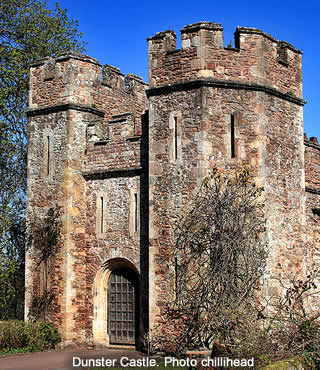Dunster |
|
 |
|||
A medieval village with a fairytale castle |
||||
|
||||
The towns and villages of Medieval times were usually dominated by their castles and churches; by their markets and inns. Time has moved on across most of England, but not here. Hidden in Exmoor National Park, not far from the coast, is Dunster, a settlement that's proud of its age. |
||||
The long, wide High Street provides the best snapshot of the village's heritage. The Luttrell Arms pub has been there for 500 years, and the nunnery's even older than that. The road's lined with thatched cottages, and weathered stone shops. Altogether, there are over 200 listed buildings. |
||||
The most noticeable of these is the Yarn Market, standing right in the middle of the High Street. Its strange, hat-like shape provides one of the most recognisable images of Dunster. It was built in 1590 to shelter wool and cloth traders from the rain. These products were the pride of the village; they were made at the local mills, and their reputation was top-notch. |
||||
The cloth trade's not what it once was, but at Dunster Working Water Mill, the traditional crafts are still well remembered. This building's an 18th-century construction, but it's built on the site of a much older mill, which was mentioned in the Domesday Book of 1086. Inside, a small museum looks at this long history, while the antique machinery keeps itself busy by still producing saleable cloth. |
||||
Back on the High Street, there are plenty more places to spend your money. Hand-made confectioners stand shoulder-to-shoulder with second-hand book stores, antique dealers and local crafts boutiques. |
||||
Looking over this scene from its high hill is Dunster Castle, a tall, regal building made from red sandstone. It rises up out of the trees like something from a child's drawing. For 600 years it was home to the Luttrell family. A 19th-century remodelling gave the place some ornate details, such as the oak staircase and the plasterwork ceilings. In recent years the National Trust have taken charge, so the whole building's open to the public. You can see what life was like for the wealthy Luttrells - or you can pretend to be one yourself, by taking up their favourite hobbies. You can play the piano, have a game of snooker, or even handle a shotgun. |
||||
Outside, the grounds are filled with over 1000 trees. The warmer southern slopes manage to grow tropical fruit like strawberries and lemons. There are lots of paths and trails to explore; the most taxing takes you all the way to the top of the hill. The climb is worth it. A small summerhouse provides a 360 degree bird's-eye view across the countryside, and out to sea. |
||||
Most of the land spreading out below your feet is within Exmoor National Park. From Dunster you can venture into its 267 square miles of multi-coloured moors, hills and valleys. Before you leave, pop into the National Park Centre, on the High Street. Its information on walking routes, picnic spots and cycle trails will help you make the most of your time. |
||||
|
||||
|
Pocket Britain is optimised for use on a smartphone or tablet with internet access. All content is subject to copyright. All reasonable methods have been used to ensure information supplied is accurate at the time of publication. However, it is advisable to check information before relying on it. Privacy Policy |